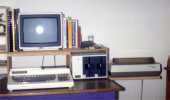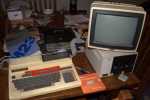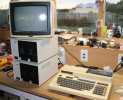SORD M23
The SORD M23 was our first "home" computer, purchased in August 1982.
It wasn't really the kind of home computer you'd expect - pretty lousy for games and not overly common - but it was the model that Dad had helped choose for the Southland County Council, where he was County Surveyor. At the Council it replaced a Monroe 1880 programmable desktop calculator which was used for survey calculations. With it's maths co-processor it was ideal for survey calculations, and the PIPS system (a kind-of hybrid database and spreadsheet) was useful for other record keeping. Dad wrote survey calculation software in BASIC-II, a structured BASIC well ahead of its time, and this software was used at the Council and by a number of other survey firms around Southland. The SORD M23 came in a number of models, the main differences being storage:
- SORD M23 mk I - dual 3.5 inch floppy drives
- SORD M23 mk III - dual 5.25 inch SSQD floppy drives
- SORD M23 mk V - dual 8 inch floppy drives
- SORD M23 mk X - Winchester hard disk drive
- SORD M23 mk 41 - dual 5.25 inch DSHD floppy drives
The only models I've seen in the flesh are the mk III and mk 41. Dad had the mk III variant, but newer models had mk 41 drives - to copy his Survey Package to that format he would borrow the drive unit and controller from the other user and use a special patched version of SORD FDOS which supported both formats with enhanced copy and format commands.
SORD's documentation makes mention of the M23B variants with only 64 kb of memory.
Apart from the maths co-processor, another option available was the graphics board, an expansion which allowed bitmapped colour graphics accessed from BASIC using a special enabling statement followed by PRINT statements in SGL (SORD Graphics Language). I'm sure dad borrowed a computer with the graphics board, but I can't remember the circumstances and didn't start using SGL until he upgraded to an M68.
My collection has two M23 mk III's and the M23EX, a later model consisting of an M23 mk 41 in an M68 case.
M23 #1
History: In 2005 I started looking for information on old SORD computers, and found a newsgroup post from several years earlier from a guy in Christchurch who had an M23 with various software packages and was looking to dispose of it. I made contact, and found that several years earler he had sold it to a collector in Dunedin. Around 2008 I saw an M23 for sale on Trademe with colour monitor and won the auction. When I travelled to Dunedin to pick it up it turned out to be the same unit.
Specification: This was a SORD M23 mk III with dual SSQD drive unit and colour display. It included a range of software including games disk, PIPS III and various tutorials. Interestingly enough this unit came boxed - the outer box had the newer curved SORD logo dating from the M68 era, while the computer itself had chips with 1981 date codes.
Restoration: This machine wasn't too happy - but fortunately the problems were resolved with generous amount of IPA and re-seating of various chips. The DIP switches on the rear panel appear to be a little problematic - I cleaned them with CRC CO and the unit booted up again. The disk drives appeared to be a little intermittent, with Drive #0 giving occasional read errors..
M23 #2
History: this was dad's original M23, sold to a Gore surveyor in August 1986. The manager of a company I used to work for spotted it in a shared storage area in 2008 and mentioned it to me. I made some enquiries about its history and picked it up shortly afterwards. Within a couple of months I had scored two M23's.
Specification: This was a SORD M23 mk III with APU (Arithmetic Processing Unit - an AMD am9511), dual SSQD drive unit and green monochrome display.
Restoration: on pickup the machine was dusty but functional - plugging it all in, I was greeted with the familiar "SET DISKETTE AND STRIKE ANY KEY" message followed by a blocky map of New Zealand and SURVEY PACKAGE COPYRIGHT I R JOLL. No long after there was a bang and some acrid smoke, so I hit the power pretty quickly - my first experience of RIFA X2 mains supression capacitors! After replacing the cap in this (and the other M23, just in case) I had two working M23's.
 Original invoice for dad's M23 |
 The family M23 in 1985 |
 The family M23 after pickup in 2008 |
 M23s being tested in 2009 |
Teac 100tpi disk drives
My main issue has been with disk drives. SORD used Teac drives with a non-standard 100 tpi track density - only Commodore seems to have used the same, with their 8050 drives. Both cabinets had well used drive 0's - M23 #2 even had a rubber band as the drive belt, a modification dad made in the late 80's which actually worked until the machine was retired sometime in the early-mid 90's! To get a working system I swapped drives, so I have a drive unit consisting of two good drives marked "Drive 1" and another with two unreliable drives marked "Drive 0." I don't hold out much hope of finding good Teac 100 tpi drives any time soon, but have been meaning to experiment with using HD drives in the same housing - the interface is the same so it's possible FDOS will just pretend it's got 77 tracks and work.
M23EX
History: The M23EX is the first SORD I found on Trademe in 2006, and when I first purchased it I assumed the seller had gotten things wrong - as far as I could tell he had posted a photo of an M68! It turned out to be a late version of the M23, housed in an M68 case with the same monitor, built-in mk 41 (DSHD) drives and separate keyboard.
Restoration: Although it's my first M23 I haven't tested this unit yet!
Other M23s
Those are my M23s, but in researching the history of dad's one he gave me a ton of other information - off the top of his head he reeled off what seemed to be the full history of every M23 he'd ever seen!
The SDC had the M23 mkIII with the colour monitor which they bought at the same time as I did. G. McMillan also had a mkIV with colour monitor and a golfball printer which I borrowed to print the manual. Albie Naylor had a mkIV as did Ralph Moir. Noel Bonisch and Dennis Thompson both had mkIII's. Graham McMillan and I wrote a structural engineering package which he sold to NZ Police and an engineer in the NI somewhere - I was not involved with the support.
Albies M23 was kept by his family when his practise was sold after his death. Don bought Noel's old M23 mkIII. SDC sold theres to Greg Erskine and it ended up in the dump. I do not know what happened to Dennis's mkIII. I think Don dumped the old mkIII but still has the mkIV. Graham lost his M23 in the factory fire.
The basic machine came with a basic language very similar to GWBasic with line numbers and no structure or compiler. The structural package was writer in it as the source code which Graham purchased was in GWBasic so conversion was not that difficult but it has to be converted to metric units. The colour and position was controlled with ANSI escape codes. The problem was that the Japanese escape code was a different ascii code to the American ascii code so graphics would only printout on a printer with the Japanese chip in it. On the M68 we got around the problem by using a HPGL emulator and wrote our output in HPGL (I also wrote it for Houston, SORD and Roland plotters). I think Noel had a Roland and SDC had a SORD. The later versions of the software only supported HPGL as it had become the standard graphics language by that stage.
Website Copyright © 2018 Andrew Joll